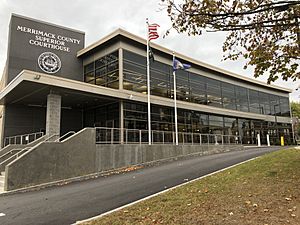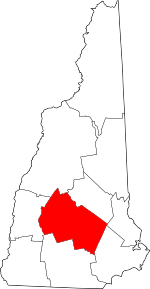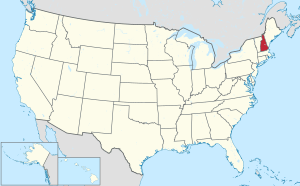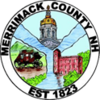Merrimack County, New Hampshire facts for kids
Quick facts for kids
Merrimack County
|
||
|---|---|---|

Merrimack County Courthouse, 2019
|
||
|
||

Location within the U.S. state of New Hampshire
|
||
 New Hampshire's location within the U.S. |
||
| Country | ||
| State | ||
| Founded | 1823 | |
| Named for | Merrimack River | |
| Seat | Concord | |
| Largest city | Concord | |
| Area | ||
| • Total | 955.0 sq mi (2,473 km2) | |
| • Land | 932.9 sq mi (2,416 km2) | |
| • Water | 22.1 sq mi (57 km2) 2.3% | |
| Population
(2020)
|
||
| • Total | 153,808 | |
| • Estimate
(2022)
|
156,020 |
|
| • Density | 167.2/sq mi (64.6/km2) | |
| Time zone | UTC−5 (Eastern) | |
| • Summer (DST) | UTC−4 (EDT) | |
| Congressional districts | 1st, 2nd | |
Merrimack County is a county in the state of New Hampshire. It is the third largest county in New Hampshire by population. In 2020, about 153,808 people lived here.
The main city and county seat of Merrimack County is Concord. Concord is also the capital city of New Hampshire. The county was created in 1823. It was formed from parts of Hillsborough and Rockingham counties. The county gets its name from the Merrimack River.
Contents
Geography of Merrimack County
Merrimack County covers a total area of about 956 square miles (2,476 square kilometers). Most of this area, about 934 square miles (2,419 square kilometers), is land. The remaining 22 square miles (57 square kilometers) is water, like rivers and lakes. This makes it the third largest county in New Hampshire by land area.
The highest point in Merrimack County is Mount Kearsarge. It is located on the border of the towns of Warner and Wilmot. Mount Kearsarge stands at 2,937 feet (895 meters) tall.
Neighboring Counties
Merrimack County shares its borders with several other counties:
- Belknap County (to the northeast)
- Strafford County (to the east)
- Rockingham County (to the southeast)
- Hillsborough County (to the south)
- Sullivan County (to the west)
- Grafton County (to the northwest)
Protected Natural Areas
- John Hay National Wildlife Refuge is a special area in the county that protects wildlife.
Population and People
| Historical population | |||
|---|---|---|---|
| Census | Pop. | %± | |
| 1830 | 34,614 | — | |
| 1840 | 36,253 | 4.7% | |
| 1850 | 40,337 | 11.3% | |
| 1860 | 41,408 | 2.7% | |
| 1870 | 42,151 | 1.8% | |
| 1880 | 46,300 | 9.8% | |
| 1890 | 49,435 | 6.8% | |
| 1900 | 52,430 | 6.1% | |
| 1910 | 53,335 | 1.7% | |
| 1920 | 51,770 | −2.9% | |
| 1930 | 56,152 | 8.5% | |
| 1940 | 60,710 | 8.1% | |
| 1950 | 63,022 | 3.8% | |
| 1960 | 67,785 | 7.6% | |
| 1970 | 80,925 | 19.4% | |
| 1980 | 98,302 | 21.5% | |
| 1990 | 120,005 | 22.1% | |
| 2000 | 136,225 | 13.5% | |
| 2010 | 146,445 | 7.5% | |
| 2020 | 153,808 | 5.0% | |
| 2022 (est.) | 156,020 | 6.5% | |
| U.S. Decennial Census 1790–1960 1900–1990 1990–2000 2010–2020 |
|||
In 2010, the county had 146,445 people living there. Most people (95.3%) were white. About 1.6% were Asian, and 1.0% were Black or African American. People of Hispanic or Latino origin made up 1.6% of the population.
The average age of people in Merrimack County in 2010 was 41.4 years old. About 31.3% of homes had children under 18 living in them.
Cities and Towns
Merrimack County has two cities and many towns.
Cities
Towns
Census-Designated Places (CDPs)
CDPs are areas that are like towns but are not officially incorporated as towns.
Villages
Villages are smaller communities within towns.
Education
Merrimack County has many school districts. These districts manage schools for students from kindergarten through 12th grade.
K-12 School Districts
These districts cover all grades from kindergarten to high school.
- Bow School District
- Concord School District
- Franklin School District
- Hopkinton School District
- Kearsarge Regional School District
- Merrimack Valley School District
- Newfound Area School District
- Pembroke School District
- Pittsfield School District
- Shaker Regional School District
- Winnisquam Regional School District
Secondary School Districts
These districts focus on high school education.
- John Stark Regional School District
Elementary School Districts
These districts manage schools for younger students, usually up to 8th grade.
- Allenstown School District
- Andover School District
- Chichester School District
- Dunbarton School District
- Epsom School District
- Henniker School District
- Hill School District
- Hooksett School District
Students from Hooksett often attend high school at Pinkerton Academy. This school is in Derry, which is in Rockingham County.
See also
 In Spanish: Condado de Merrimack (Nuevo Hampshire) para niños
In Spanish: Condado de Merrimack (Nuevo Hampshire) para niños


